James W. Dalton Highway Trip Log (by Linda Hulteen)
The trip began in Eagle River, Alaska with two vehicles and five people at 8:30 AM, Alaska Standard Time, on Friday, May 22, 1998. The trip ended 1,763 miles later on May 26, 1998 in Eagle River -- two very dirty vehicles and five tired people returned.
|
The Dalton Highway, a.k.a., the "haul road", is 414 miles long and connects the Elliott Highway (north of Fairbanks) to Deadhorse, Alaska -- the farthest north you can drive on Alaska's road system. The road is gravel, the steepest grade is 12 percent (a 12 foot rise in elevation for every 100 foot of travel), the highest summit is Atigun Pass at 4,800 feet, and the major attraction is the Trans-Alaska Pipeline. The road is open to travelers all year. |

The Dalton Highway |
The highway is named for James William Dalton, an Arctic engineer involved in early oil exploration efforts on the North Slope of Alaska. It was built as a haul road between the Yukon River and Prudhoe Bay during construction of the Trans-Alaska pipeline, and was originally called the North Slope Haul Road. Construction of the road began April 29, 1974, and was completed 5 months later. The road is 28 feet wide with 3-6 feet of gravel surfacing. Some sections of road are underlain with plastic foam insulation to prevent thawing of the permafrost beneath it.
|
Construction of the 800-mile pipeline between Prudhoe Bay and Valdez took place between 1974 and 1977. The 48-inch diameter pipeline, of which slightly more than half is above ground, has 10 operating pump stations. The control center is in Valdez. Design, construction, and operation of the pipeline are managed by Alyeska Pipeline Service Company, a consortium of seven oil companies (BP, ARCO, Exxon, Mobil, Amerada Hess, Phillips, and Unocal). |
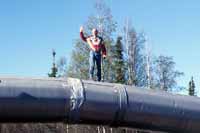
Eric standing on the pipeline |
|
The Bureau of Land Management manages 2.1 million acres of public land along the Dalton Highway between the Yukon River and Pump Station No. 3. |
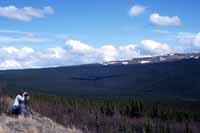
Photographing a broad landscape |
The first major milestone on the haul road is the mighty Yukon River. Anyone interested in river hydraulics might be interested to know that the river flow prior to spring breakup is 15,000 cfs. During spring break up it jumps to 500,000 cfs. The Yukon River Bridge was named for E.L. Patton (after his death in 1982), the president of Alyeska Pipeline Service Co. Gas, food, and lodging is available at the Yukon River. There're no services between the Yukon River and Coldfoot, 120 miles away.
Pump stations dot the highway and Alyeska Pipeline Service Co. personnel take care of the pipeline and the oil flowing through on its 800-mile journey to Valdez, Alaska.
|
At Milepost 115.3 is the Arctic Circle -- a popular photo spot. Some folks get here and simply turn around and head back. Not our group. We assembled for a group photograph, stretched our legs, got back in the cars, and headed north. |
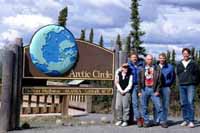
Group photo at the Arctic Circle sign |
The next major milestone is Coldfoot -- a historic mining camp. You can buy gas, food, and gifts, and there's even lodging available. The next available services are 244 miles to the north.
|
Driving north from Coldfoot we went through some positively beautiful country. We drove up Chandalar Shelf and through Atigun Pass, down over the Brooks Range, out into the flats, and finally into Deadhorse / Prudhoe Bay at the top of our world. |
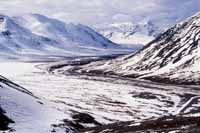
Looking south from Atigun Pass |
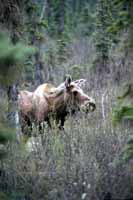
Moose |
Over the course of the five-day round trip, we were fortunate enough to observe an abundance of wildlife. We saw several moose, many very close to the road; loads of caribou; tons of sheep; swans, geese, ducks, and other waterfowl; several eagles; and innumerable snowshoe hares and Arctic ground squirrels. One of the wildlife highlights of the trip was the grizzly bears. We had five separate grizzly bear sitings all of which were "blonde". Two bears were right next to the road and posed patiently (mostly) for our endless enjoyment and photographs. The other three were away from road, but close enough to enjoy watching and photographing. |
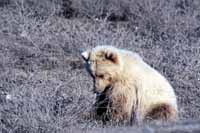
A blonde bear sitting 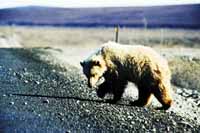
A blonde bear walking |
|
On Sunday morning we saw a what appeared to be a bunch of hay bales across the river from our campsite. The lumps turned out to be a sleeping herd of Musk Ox. The four of us from Alaska had never hoped that we'd see Musk Ox in the wild; the Californian among us hadn't known not to hope for it. It's just not everyday you get see Musk Ox. We sat back on a bank and watched the herd of Musk Ox slowly wake up and begin wondering around. We watched and took lots of photographs and finally we had to press on -- the Arctic Ocean was waiting for us. |
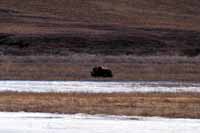
Musk Ox |
|
At 11:30 AM, or thereabouts, on Sunday, May 24, 1998 we arrived at Deadhorse, Alaska. Twenty-five people actually live in Deadhorse. The rest of the people -- thousands at a time -- work two weeks on and two weeks off supporting the oil field developments known as Prudhoe Bay. The temperature in Deadhorse on our arrival was 34 degrees -- 14 degrees with the wind-chill factor accounted for -- it was foggy, windy, and just plain cold. We paid our money and set off on a tour bus to the Arctic Ocean. Once we arrived at the shore (15 minutes later, or so), we scrambled out of the bus and immediately went onto the frozen Arctic Ocean. Actually, it was slushy and there were enough puddles to splash around in and get our hands (in Kurt's case his hair) wet. We spent only four hours in Deadhorse and then headed back south. We left, in part, because of the weather, in part, to the lack of anything other than oil fields and well houses to look at, and because we had to be back in Eagle River in two-and-a-half days. |
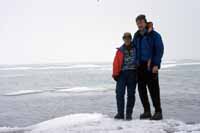
Linda and Kurt at the Arctic Ocean 
Eric at the Arctic Ocean |
Several hours outside of Deadhorse heading south, we came upon a herd of three extra-large bull Musk Ox -- directly at the side of the road. We stopped, of course, and watched them, photographed them, and watched some more. Finally, we had to move on.
This is meant to be a log of our trip. See the Internet for numerous articles on traveling the haul road and opportunities.